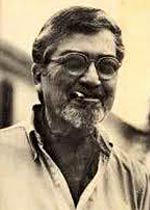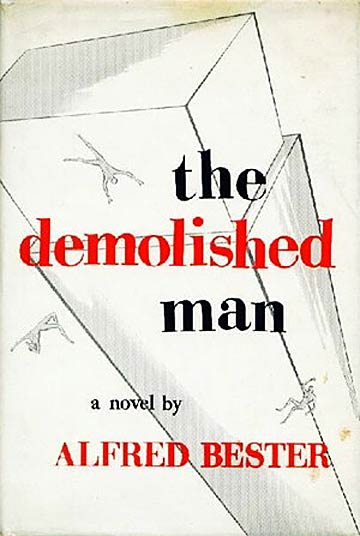GMRC Review: The Demolished Man by Alfred Bester
 Rhonda Knight is a frequent contributor to WWEnd through her many reviews and her excellent blog series Automata 101 and Outside the Norm. This is Rhonda’s sixth featured review for the Grand Master Reading Challenge. She won the GMRC Review of the Month for March for her review of The Word for World is Forest by Ursula K. Le Guin.
Rhonda Knight is a frequent contributor to WWEnd through her many reviews and her excellent blog series Automata 101 and Outside the Norm. This is Rhonda’s sixth featured review for the Grand Master Reading Challenge. She won the GMRC Review of the Month for March for her review of The Word for World is Forest by Ursula K. Le Guin.
This will be the seventh Worlds Without End review of Alfred Bester’s The Demolished Man. I wonder what new I might contribute; however, since I need to write a review of this Hugo winner to fulfill one of my other reading challenges, I’ll give this a shot as a pro and con list. This means that there will be spoilers. Be warned, if you have not read the book or want a more conventional review, choose one of the other reviews; they are good.
What I enjoyed:
1. The police procedural aspect.
I always thought that Asimov’s The Caves of Steel was the first detective science fiction novel. However, my research shows that Bester published a serial version of The Demolished Man beginning in January 1952 in Galaxy Science Fiction. Asimov’s serial of The Caves of Steel appeared in the same magazine in October to December 1953. These dates—in one sense—call into question the famous Asimov anecdote that he wrote The Caves of Steel to prove wrong John W. Campbell’s claim that mystery and science fiction were incompatible. If Campbell had been reading his competition’s magazine, then he would have seen that the feat had already been accomplished.
2. The cat-and-mouse game.
The machinations between murderer Ben Reich and detective Lincoln Powell are interesting to read. To be fair to Campbell, The Demolished Man is a police procedural, but it is not a whodunit, which was probably the type of mystery Campbell was referring to. The Demolished Man is a whydunnit, in that we know from early in the book who will be murdered, who will murder him and how the murder will be accomplished. The motive is murkier, and the denouement finally brings clarity to Ben Reich’s motives. Bester is at his best when he is illuminating the chess moves between Reich and Powell, as Powell tries to uncover means, motive and opportunity, and they both use their considerable syndicates to cherchez la femme, Barbara D’Courtney, the witness to the murder. My favorite piece of writing comes through Bester’s description of this:
Like an anatomical chart of the blood system, colored red for arteries and blue for veins, the underworld and overworld spread their networks. From Guild headquarters the word passed to instructors and students, to their families, to their friends, to their friends’ friends, to casual acquaintances, to strangers met in business. From Quizzard’s Casino the word was passed from croupier to gamblers, to confidence men, to the heavy racketeers, to the light thieves, to hustlers, steerers, and suckers, to the shadowy fringe of the semi-crook and near-honest. (107)
3. Style and Tone.
Style: Postmodern.
When I read Karel Capek’s War with the Newts (1936), I was very surprised that a novel written that early in the twentieth century used postmodern storytelling techniques. It was a pastiche of narrative, academic reports and newspaper clippings. I should have learned my lesson, but I was still surprised by Bester’s use of textual embellishments and linguistic play. He traces the telepathic conversations of the espers through patterns of language, such as spiderwebs, columns, and other abstract designs. I wish that I could reproduce one here. You’ll just have to read the book. Some of his characters’ names emerge through playing with the sounds of symbols, such as @kins, Wyg&, and ¼maine. Bester coins new words and invents slang that always reminds us that we are in a different time and place.
Tone: Hardboiled.
Both protagonist and antagonist have a hard-boiled edge worthy of Hammett or Chandler. Linc Powell’s address to a room full of suspects demonstrates this:
“He paused and lit a cigarette. ‘You all know, of course, I’m a peeper. Probably this fact has alarmed some of you. You imagine that I’m standing here like some mind-peeping monster, probing your mental plumbing. Well… Jo ¼maine wouldn’t let me if I could. And frankly, if I could, I wouldn’t be standing here, I’d be standing on the throne of the universe practically indistinguishable from God. I notice that none of you have commented on that resemblance so far…’” (76).
Also, much of the setting sounds like it is straight from the pen of Raymond Chandler:
Quizzard’s Casino had been cleaned and polished during the afternoon break… the only break in a gambler’s day. The EO and Roulette tables were brushed, the Birdcage sparkled, the Hazard and Bank Crap boards gleamed green and white. In crystal globes, the ivory dice glistened like sugar cubes. On the cashier’s desk, sovereigns, the standard coin of gambling and the underworld, were racked in tempting stacks. Ben Reich sat at the billiard table with Jerry Church and Keno Quizzard, the blind croupier. Quizzard was a giant pulp-like man, fat, with flaming red beard, dead white skin, and malevolent dead white eyes. (94)
A blind, albino croupier. I’m surprised Chandler did not think of him first.
The aspects of The Demolished Man that I liked demonstrate a universalism of tone, style and genre(s) that transcends the time in which the book was written. The aspects that I didn’t enjoy as much relate much more to the date of the book’s creation.
What I didn’t like:
1. Freud.
This book could not have been written without Freudian psychology. The concept of the conscious and unconscious is the basis of Bester’s culture and therefore intrinsic to the book. The espers’ telepathic abilities enable them to probe others’ unconscious thoughts and desires. This facet of Freudian psychology works well and does hold up over time. The Oedipus and Electra Complexes that form other important parts of the plot do not hold up as well and seem clunky in their use. For example, the regressing of Barbara D’Courtney to an infantile mental state so that she can fall in love with her new “daddy,” Linc Powell, seems silly to me:
“’Hello, Papa. I had a bad dream.’
‘I know, baby. I had to give it to you. It was an experiment on that big oaf.’
‘Gimme a kiss.’
He kissed her forehead. ‘You’re growing up fast,’ he smiled. You were just baby talking yesterday.’
‘I’m growing up because you promised to wait for me.’
‘It’s a promise, Barbara.’” (189)
This Electra Complex contributes another theme in the book that I disliked which is the portrayal of women.
2. The portrayal of women.
There are several stereotypical female characters in this book: the madam, the amoral society woman, the smart girl, and the damsel in distress. The two I want to discuss are Mary Noyes, the smart, capable friend of Powell and Barbara D’Courtney, the blonde damsel in distress, who spends most of the book as either an absent object of desire or a grown woman with the mind of a child. Of course, Mary is in love with Linc, and he depends on her for moral and personal support, but he will never love her because she is too smart, too capable; in short, she does not need a “daddy.”
 Barbara D’Courtney witnesses her father’s murder and runs away. Reich and Powell search for her though much of the book, and when Powell finds her she can only relive the trauma of her father’s murder. She is then regressed to her infantile stage to heal her. Throughout the book, the reader never sees her make a decision, and she never speaks as an independent being. Lincoln falls in love with a baby in a woman’s body. She, on the other hand, as a victim of the Electra Complex, has no choice but to bond with her daddy. Bester’s Barbara pales in comparison with the women that appear in hard boiled novels, which in and of themselves are not famous for creating positive female role models. At least the femme fatales in Cain, Chandler, and Hammett are tough, strong and get to say some snappy dialogue.
Barbara D’Courtney witnesses her father’s murder and runs away. Reich and Powell search for her though much of the book, and when Powell finds her she can only relive the trauma of her father’s murder. She is then regressed to her infantile stage to heal her. Throughout the book, the reader never sees her make a decision, and she never speaks as an independent being. Lincoln falls in love with a baby in a woman’s body. She, on the other hand, as a victim of the Electra Complex, has no choice but to bond with her daddy. Bester’s Barbara pales in comparison with the women that appear in hard boiled novels, which in and of themselves are not famous for creating positive female role models. At least the femme fatales in Cain, Chandler, and Hammett are tough, strong and get to say some snappy dialogue.
Conclusion:
The Demolished Man is certainly worth the read and not just for its “legacy value.” However, I would like to end with Harry Harrison’s discussion of its legacy:
“This kind of novel had never happened before. Other writers have since used and built upon its structure: Blish, Zelazny, and Delany come to mind. The New Wave mined its assets, and the cyberpunks echo only dim whispers of The Demolished Man’s rolling thunder. But Bester came first—and is still the master.” (From the Introduction, viii-ix).



















 Full Details
Full Details



7 Comments
A favorite of mine, introduced to me by Dave! The psychology is indeed Freudian, but boy, the senses-shattering pace, the quick-fire prose and Reich’s atavistic pursuit makes up for the antiquated complexes like the id and super ego. The book blew me away and I remember fondly how I finished it in record time. It does seem that the earlier SF works considered the roles of women exigent and did nothing more with their characters but mere placeholders. It’s no excuse really, for as groundbreaking as this novel was in terms of its postmodern experimentation, it would have been even more consequential had it established a clamorous female protagonist other than the stereotypical. I think Bester might have missed a trick here. I love the ending, so typical of the Bester cloaking device: human monsters are still really human. ""Be grateful that you only see the outward man. Be grateful that you never see the passions, the hatreds, the jealousies, the malice, the sicknesses… Be grateful you rarely see the frightening truth in people." Stunning Bester dissimulation! Awesome review, thanks @Rhonda!
Emil, I thought a lot about Freud as I was writing the review. I think we could say without Freud there would be no The Demolished Man, so it is hard to disparage Bester’s use of Freudian psychology too much. Besides some of Freud’s thoughts did not age as well as others.
Being a Jung myself, I won’t disagree with you on Freud. That bit about aging, that is 🙂
I always liked Jung better!
Great review! The Pro/Con list worked really well. I was also shocked by how postmodern the style was, though I’m not sure I had any reason to be surprised. I guess it just took me off guard.While I generally enjoy the inclusion of the field of psychology in any SF, I do struggle with the use of Freud. Like all fields of science, psychology changes so fast it almost always dates the book so I tend to be forgiving of that sort of problem. I do have a problem with the way Freud is used in many instances, particularly in this one, which is to justify/excuse the shackling of female characters into stereotypical and submissive roles. I’ll agree The Demolished Man wouldn’t exist without Freud, but I didn’t think Barbara’s character was absolutely necessary or that she couldn’t have been something more, even at a time that Freudian psychology was much more vogue.
Jeremy, Thanks for your kind words and saying some of my ideas more clearly than I did. The thing that struck me the most about the women characters was how weak they were in comparison to women in the hard-boiled genre. I probably would not have noticed it as much if they seemed on par with women in the genre that clearly inspired much of Bester’s approach. After I wrote the review, I realized that Mary is based on the Della Street stereotype. However, Bester brings the woman’s crush to the forefront rather than leaving it unspoken as Gardner did. By making Mary more forthright, he makes her more vulnerable, and the readers see Linc crush her hopes and dreams early in the book and then continue to use her because she is valuable and convenient. At least Perry Mason was kind. Thanks again.
A very impressive, professional review. That’s what I kept thinking as I was reading it, "professional". Thank you for taking the time to write it.
Sorry, the comment form is closed at this time.